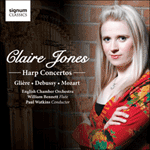In January 1907 Falla wrote to Debussy asking for advice prior to a performance he was about to give in Madrid of the
Danse sacrée et danse profane. In his reply Debussy was not prepared to go into much detail. He referred to the ‘colour’ of the two dances, comparing the ‘gravity’ of the one with the ‘grace’ of the other and expressed himself content to leave the performance to the Spaniard’s own musical taste. Falla was going to play the
Danses on the piano, but they had originally been composed for the harp. In 1894 Gustave Lyon had invented a chromatic harp which, by virtue of an extra set of strings, removed the need for the pedals found on the conventional instrument. The Paris firm of Pleyel, with the intention of popularizing it, commissioned Debussy, amongst others, to compose something for the chromatic harp. The two
Danses, for harp and string orchestra, were composed in 1904 and were dedicated to the instrument’s inventor. It would seem that Debussy (or perhaps his publishers) had little faith in this new invention, for the score indicates that the solo part in these dances can also be played on the pedal harp (as they usually are) or on the piano. The reduction for two pianos, which also dates from 1904, was made by Debussy himself.
from notes by Peter Avis © 1999
En janvier 1907, Falla écrivit à Debussy pour lui demander ses conseils avant de donner une représentation de la
Danse sacrée et danse profane à Madrid. Debussy répondit mais sans se lancer dans beaucoup de détails. Il faisait allusion à «la couleur» des deux danses, comparant «la gravité» de l’une avec «la grâce» de l’autre, et se disant satisfait d’en laisser l’exécution au sens musical de l’Espagnol. Falla allait jouer les
Danses au piano, mais elles avaient été composées pour la harpe à l’origine. En 1894, Gustave Lyon avait inventé une harpe chromatique qui, grâce à une série supplémentaire de cordes, supprimait la nécessité des pédales qui se trouvent sur l’instrument conventionnel. Dans l’intention de rendre ce nouvel instrument populaire, la compagnie parisienne Pleyel avait demandé à Debussy, parmi d’autres compositeurs, de composer une pièce pour la harpe chromatique. Les deux
Danses, pour harpe et orchestre à cordes, furent composées en 1904 et dédicacées à l’inventeur de l’instrument. Debussy (ou peut-être ses éditeurs) n’avait guère confiance dans cette nouvelle invention, puisque la partition indique que la partie solo de ces danses peut aussi être jouée sur la harpe à pédales (comme d’habitude) ou au piano. La réduction pour deux pianos qui date de 1904 est l’œuvre de Debussy lui-même.
extrait des notes rédigées par Peter Avis © 1999
Français: Alain Midoux
Im Januar 1907 schrieb Falla an Debussy und bat um seinen Rat bei der Vorbereitung einer Aufführung des
Danse sacrée et danse profane in Madrid. In seiner Antwort zeigte sich Debussy nicht bereit, sehr ins Detail zu gehen. Er erwähnte die „Klangfarbe“ der beiden Tänze, verglich die „Gewichtigkeit“ des einen mit der „Grazie“ des anderen und erklärte sich ansonsten damit zufrieden, die Interpretation des Werks dem persönlichen Musikgeschmack des Spaniers zu überlassen: Falla wollte die
Danses auf dem Klavier spielen, obwohl sie ursprünglich für Harfe komponiert worden waren. 1894 hatte Gustave Lyon eine chromatische Harfe erfunden, die dank eines zusätzlichen Satzes Saiten die Pedale unnötig machte, wie man sie beim konventionellen Instrument findet. Die Pariser Firma Pleyel hatte, um sie bekannt zu machen, unter anderem Debussy beauftragt, etwas für die chromatische Harfe zu schreiben. Die zwei Danses für Harfe und Streichorchester entstanden 1904 und waren dem Erfinder des Instruments gewidmet. Wie es scheint, setzte Debussy (oder möglicherweise sein Verlag) jedoch wenig Vertrauen in diese neue Erfindung, denn in der Partitur steht, daß der Solopart der Tänze auch auf der Pedalharfe gespielt werden kann (was inzwischen die Regel ist), oder auf dem Klavier. Die ebenfalls 1904 entstandene Bearbeitung für zwei Klaviere wurde von Debussy selbst vorgenommen.
aus dem Begleittext von Peter Avis © 1999
Deutsch: Anne Steeb/Bernd Müller


 Glière, Debussy & Mozart: Harp Concertos
Glière, Debussy & Mozart: Harp Concertos
